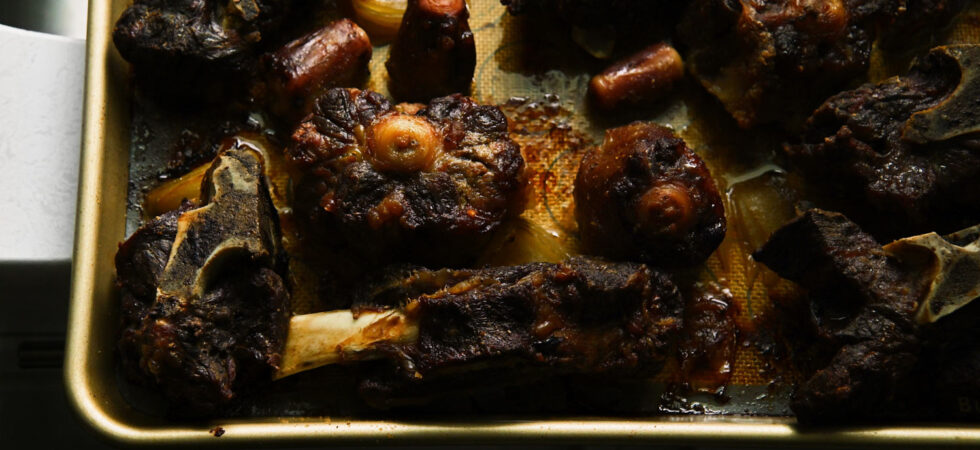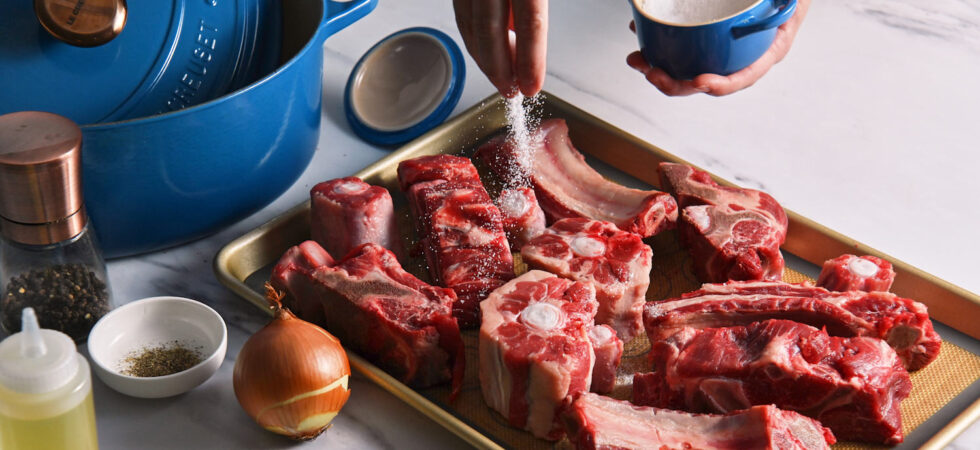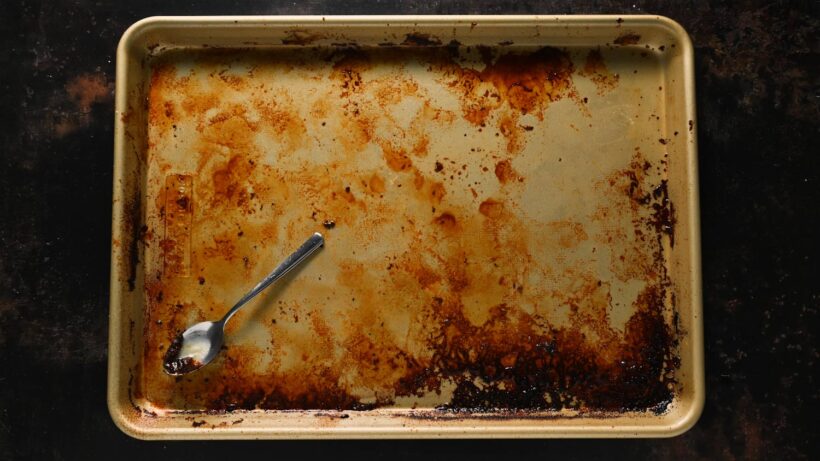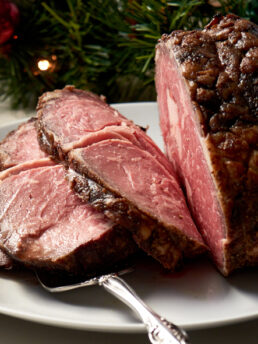Savor the Flavor: How to Make a Deliciously Rich Beef Stock at Home

Add depth to your favorite soups and stews with homemade beef stock. This stock is rich and flavorful for a few reasons:
- It uses a variety of beef bones for superior taste and texture.
- The bones are roasted to increase their savoriness.
- The stock is gently simmered for 6+ hours to fully infuse all that flavor into the broth.
We love that low and slow life. Set it and forget it, but like don’t really forget it!

Get the Recipe: Beef Stock
Ingredients
- 1½ lbs marrow bones or neckbones
- 1½ lbs oxtail
- 3-3½ lbs beef back ribs
- 1 medium sweet onion, quartered
- 2 teaspoons Diamond Crystal kosher salt
- 1 teaspoon ground black pepper
- ¼ cup canola oil
- 12 cups water
- 2-3 medium carrots
- 3 celery stalks
- 2 bay leaves
- ½ a head of garlic
- 1 tsp whole black peppercorns
- 4 sprigs fresh thyme
Equipment
- ¼ sheet baking tray
- silicone baking mat (optional)
- aluminum foil
- dutch oven or stock pot (minimum 7qt)
- fat separator (optional)
- knife
- cutting board
- disposable tea bag or kitchen twine (optional)
- Fine Mesh Strainer
- tongs
Instructions
- First, begin preheating the oven to 400°F (204°C). Next, cut the top and bottom off of the onion and quarter it. Set half of the quartered onion and the sliced top and bottom aside for later. Place the other pieces of the onion along with the beef bones you have selected for your stock onto a baking sheet. Coat with oil and season with salt and pepper. Toss to fully coat the bones and aromatics.
- Now, cut the top off half a head of garlic and place it on a sheet of aluminum foil. Pour oil over the garlic cloves and wrap the whole thing in the foil. Place the foiled head of garlic onto the tray with the seasoned beef bones and then bake for 45-60 minutes.
- Once baked, add everything into a stock pot and fill until all of the bones are covered with water (about 12c or 2.8L). Turn the burner on to medium. While the water heats up, collect as much beef fat as you can from your baking sheet. To do this, tilt the tray over a bowl and let it all run down the sheet. Once you are left with just drips, set the bowl aside (see notes about keeping/using beef fat) and deglaze the pan.
- To deglaze your baking sheet. Boil and pour ¼ cup (60ml) or less of water onto the sheet where most of the browned bits have stuck. With a spoon (preferably wooden or silicone) gently scrape at the soaking fond until it dissolves into a warm brown pan sauce. Pour that into the stock pot as well.
- At this point you can also add in your vegetables (onion top/bottom included), herbs, and spices. Make sure to clean the vegetable and chop off carrot tops and any brown edges on the celery. Once you see little bubbles form on the surface of the stock, turn down the heat to medium-low and let it gently boil. (see notes).
- Cook for 6-8 hours or until the marrow in the bones looks pitted and the cartilage in the oxtails becomes translucent. If you see any scum forming while the stock cooks, skim it off.
- When done, strain the liquid out, separating the juice from anymore fat. Store this fat with the rest of the beef tallow if you want to keep it.
Notes
- Stock can be stored up to 4 days in the refrigerator or for up to 6 months in the freezer.
- If you want a consommé (clear stock) you will want to keep the stock to a simmer (1-2 bubbles a minute) for 12 hours. Any harsh agitation, like boiling, will cause the liquid to cloud. Most of the things I use beef stock for, don’t need the stock to be clear so I take the L on opacity and save time with a gentle boil.
- The leftover fat can be frozen in silicone molds to use for cooking veggies and other yummy things. Fat will keep for 6 months in the freezer as well.
- If you use Morton kosher salt instead of Diamond Crystal kosher salt for the roasting part, instead of 2 teaspoons (5g) Diamond Crystal kosher salt, use 1¼ teaspoon (5g) Morton Salt. Morton Salt crystals are more compact than Diamond Crystal salt crystals, so measuring by volume may cause you to over-salt if you aren’t careful.
- If you have a disposable tea bag, put all of your herbs and spices inside and drop it into the stock pot. It’ll be much easier to fish out later.
- If you want a really concentrated stock, use this French technique:
- Simmer for 12 hours
- Chill until the fat has solidified to the top of the stock and remove it
- Gently boil the stock again for 2-3 hours and reduce it by half into a demi-glace.
Nutrition

Frequently Asked Questions
Roasting beef bones before making beef stock takes you to Flavortown in a few ways:
1. Roasting caramelizes the natural sugars in the bones, creating complex and rich flavors.
2. The high heat of roasting causes the Maillard reaction to occur, a reaction between amino acids and reducing sugars to create compounds like melanoidins. This reaction is what creates the brown color and savory flavor in the beef stock.
3. Roasting also removes excess fat from the bones, resulting in a less greasy and cleaner-tasting beef stock.
I tested beef back ribs, oxtail, soup/marrow bones and neckbones to determine what I kind of already knew. basically, you need to use them all. I am so sorry! lol.
Each of these imparts a different flavor and/or texture than the other so if you want a full flavored stock, it’s best to use as may different types as you can. If you cannot find all three here’s a description to how each stock renders down. This way you can decide what works best for your tastes. This will also be helpful if you cannot find all three cuts in the store.
Beef back ribs, give the best overall flavor. The stock from these is bright, bold, and flavorful. There isn’t a ton of body, but if you only want to use one kind of bones, I would recommend these over the others. Additionally, if you want to make a gravy the body of the stock won’t even matter, as a roux will thicken the stock.
Oxtail, was my runner up in flavor. They had a noticeably lighter and less bold flavor than the beef back ribs. However, oxtail is a powerhouse in texture. Because oxtail has so much cartilage and fat, it creates a thicker bodied stock with a very silky, creamy mouthfeel. Using these bones imparts a decadent texture missing from just the beef back ribs.
Neck bones and marrow bones are mostly interchangeable. These definitely had the least amount of flavor and body of the group. Both should only be used for enhancing flavor. I say this because, the flavor that was present was beautifully deep and meaty, but it was not the bright beefy flavor of a seared steak. I attribute this to the shear amount of marrow and small amount of fat and meat in these bones. These really rounded the stock out. If you need to choose, I recommend using marrow bones over the neck bones.
If they are, you are doing it wrong. Most supermarkets sell these bones as soup bones or scraps. The bones are typically sliced no longer than 3in (7.6cm) in height.
The bones you see at a fancy restaurant where the marrow is served in a bone canoe with A Little Spoon. See what I did there. 😉 are not considered scraps and can cost at least 3 times more. In fact, some butchers will wrap and give scrap marrow bones away for free!
I like to separate my stock into different sized containers for the following cooking purposes:
– 2 oz (60ml) silicone molds for deglazing
– 2 cup (480ml) containers for stews
– 4+ cup (1L+)containers for soups
Use any combination you like, based on the above!
Ladies and gents, this doesn’t happen often, but there is a very easy solution to this. Once you have the stock strained and in a bowl or dish, place it in the refrigerator until the fat fully solidifies on top. Fat is less dense than the beef stock and will naturally settle into a perfect layer at the top of your container. Once it’s fully hardened, just use a spoon to scoop off the fat pieces. If it’s a thick enough layer, you can even just lift it right off the stock. Easy, peasy!
Of note: If you want to store the fat in uniform pieces at this point, you will need to melt it and then pour it into your molds or containers.
You can add whatever you like!
This is a base stock recipe that can be used seamlessly in a number of applications, like caramelized onion grilled cheese sandwiches or gravy for your holiday prime rib.
If you intend to add other aromatics or herbs, just keep in mind what dish you are using it in. For example, if you wanted to use it in a thai inspired beef stew, consider adding lime halves, fresh lemongrass, and ginger to the stock.
Other common additions to beef stock are tomato paste, red wine, leeks, rosemary, and parsley.



